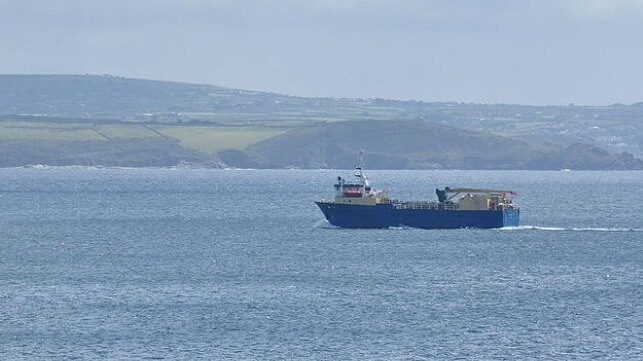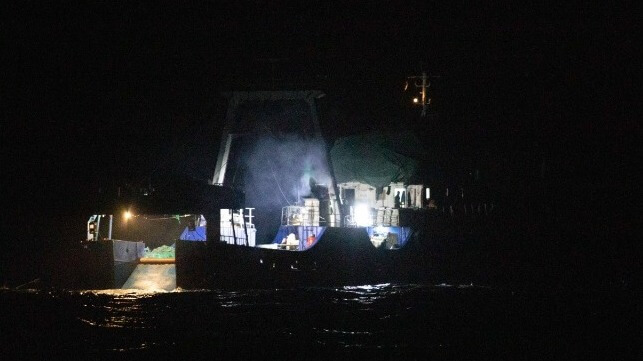Video: Vietnam Orders Salvage of Sunken Ship After Rescuing Crew
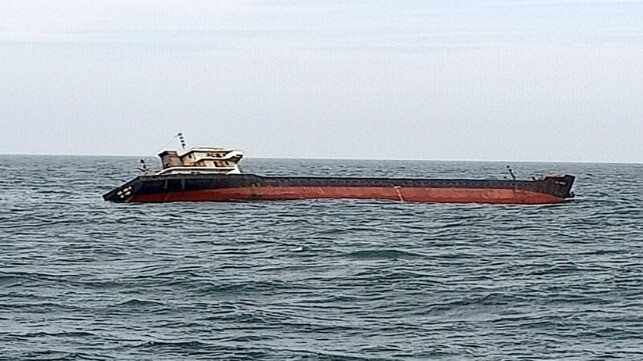
The Vietnamese Maritime Search and Rescue Coordination Center is reporting the successful rescue of 10 people from a coastal cargo ship that sank near the northern port of Hai Pong on June 22. Due to the nature of the area where the ship went down, the authorities are reporting that they have ordered the owners to come up with a salvage plan as well as to deal with the oil aboard the vessel before it leaks.
A 13-year-old general cargo ship, the Nam Thinh 126 had loaded a cargo consisting of 1,800 tons of stone and bales in the southern port of Quy Nhon. According to reports the vessel which was 259 feet long and 1,983 dwt was operating with a crew of eight and also two passengers from the owner’s company.
They reached the anchorage at Hai Pong, but shortly after midnight on June 22 called the MRCC reporting that the vessel had tilted in heavy seas. The captain was requesting an urgent rescue reporting that he was ordering everyone into the vessel’s raft. The reports indicated the vessel was rolling in heavy seas likely indicating that its cargo shifted causing the severe list.
Vietnamese officials indicated that a search was undertaken saying that the passengers and crew were rescued from their raft at mid-day. The video shows people on the deck, possibly after they were rescued from the raft.
The crew told the authorities that they had closed and locked the fuel values before abandoning ship. However, they were reporting that the vessel had 150 tons of fuel oil and three tons of diesel on board leading to fears of environmental pollution.
The Nam Thinh126 sank approximately 2.5 nautical miles south of the channel with the authorities saying it was imperative to have a plan to salvage the ship to ensure the safety of the navigation channels. In addition, they have ordered the owner to come up with a plan to drain the oil from the vessel before it leaks.
Video: Indian Coast Guard Rescues Crew from Sinking Cargo Ship
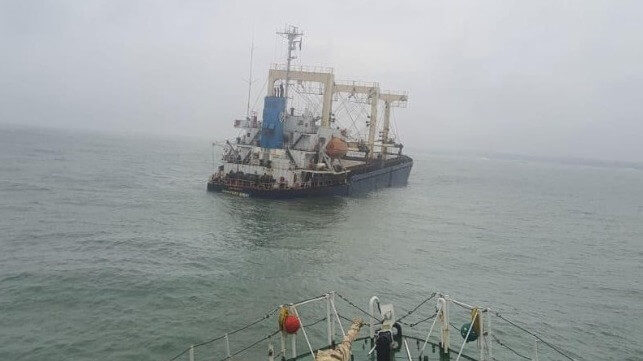
The Indian Coast Guard is hailing its efforts in what it calls a “prompt and swift Search and Rescue (SAR) Mission” saving the lives of 15 Syrian seafarers after they abandon their sinking cargo ship. They were all successfully recovered from lifeboats and lift rafts despite what the Coast Guard termed difficult conditions.
The circumstances leading up to the rescue are confused with some reports suggesting the vessel, a 32-year-old general cargo ship sailing under the flag of Belize suffered a mechanical failure while other reports suggested it possibly was intentionally grounded. The Indian Coast Guard reported receiving a distress call on June 21 with the crew telling them that they were preparing to abandon the vessel named Princess Miral.
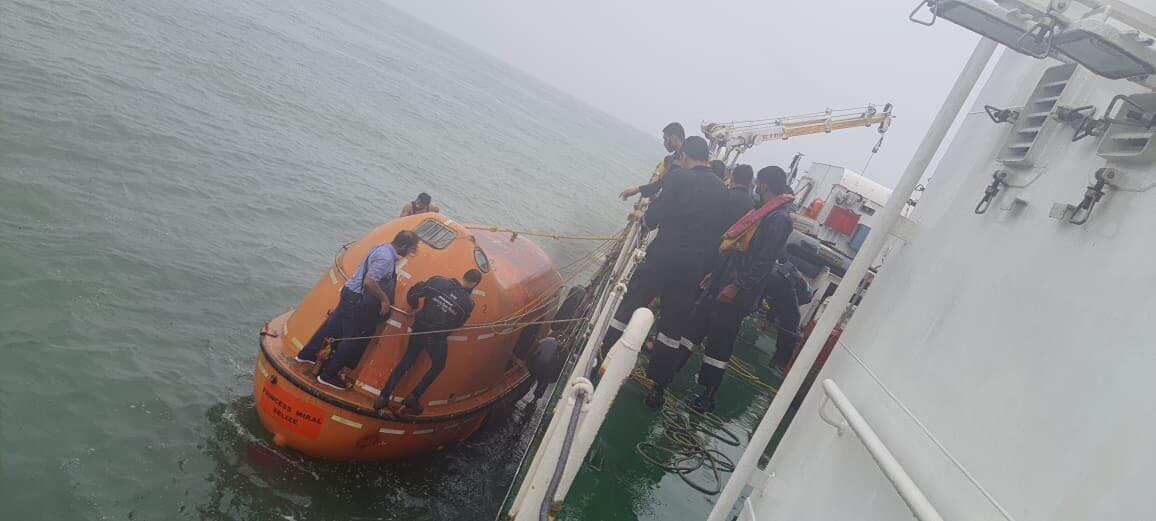
Crew was rescued from the lifeboats and rafts (Indian Coast Guard)
The 7,000 dwt general cargo ship had loaded a cargo of 8,000 tonnes of steel coil in China in May. It had stopped at the Port Klang anchorage at the beginning of June and earlier this week was located off the coast of India. It anchored north of New Mangalore, India on June 18 but later appears to have repositioned to the south of the port city. The vessel had been sailing to the Suez Canal where it was scheduled to transit at the beginning of July on its way to Lebanon.
After grounding the vessel reported hull breaches which were causing ingress of water into the holds. Pictures released by the Indian Coast Guard however show the vessel sinking by the stern.
Commander S B Venkatesh of the Indian Coast Guard told The Times of India, “In my 30 plus years in service, this was the darnedest mission undertaken in rescuing mariners. The successful operation reaffirms the Coast Guard’s capabilities.”
Two Indian Coast Guard vessels, the Vikram and Amartya were dispatched in response to the distress call. The crew was rescued from the boats and transferred to shore where they are currently being interviewed to determine more of the circumstances leading up to the emergency. It is unclear if the vessel remains afloat on a reef or if it went down after the rescue.
Video: Emergency Response for Listing Car Carrier Taking on Water
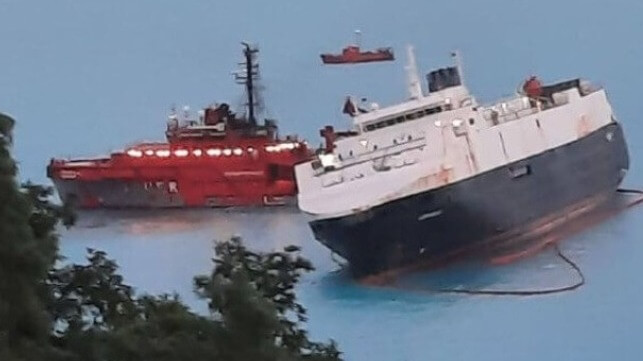
Salvage and dewatering efforts are underway for a Cameroon-flagged ro-ro car carrier, the Linder Bulut, that began taking on water near the Russian port of Tuapse on the northeastern shore of the Black Sea. Russian officials are reporting that the situation is stable and that they have been able to reduce the list by approximately two degrees.
The 22-year-old vessel, which is operating transporting cargoes across the Black Sea, was arriving at the Russian port on June 18 on its regular run from Samsun, Turkey. It was reportedly carrying a cargo of refrigerated fruits and vegetables. Reports indicate that the 4,500 dwt vessel, which is 465 feet long, is regularly crossing the Black Sea from Turkey to Russia.
Saturday evening as the vessel was approaching the entrance to the Russian port, the captain contacted the local marine rescue service and port officials requesting assistance. A statement from the Russian marine rescue service, Rosmorrechflot, said the captain reported a malfunction in the ballast water system which was causing the vessel to take on water. The crew was attempting repairs but the captain feared the vessel would capsize. He requested tugs to assist in either docking or grounding the vessel to prevent the vessel from listing further.
Eyewitnesses posted images to social media showing the vessel with a significant list to starboard. The Russian emergency rescue vessel came alongside and decided to ground the vessel while also providing additional pump capacity to dewater the ship. They grounded the vessel Saturday evening but later suspended the pumping operation overnight. By Sunday, they were reporting that water had reached the engine room of the vessel.
Divers on Sunday inspected the hull reporting that there were several holes that required repair. An emergency boom was also strung around the vessel but officials reported no oil leaks. At its worst point officials said the vessel had a 15 degree to list, but at the last report they had been successful in reducing it to 13.3 degrees. They reported that there were no injuries among the 28 crewmembers aboard. The vessel is currently about 800 feet offshore and once it is stabilized the plan is to move it to a dock in the port.
Firefighters Battle Cargo Fire on Bulker Docked in Belgium
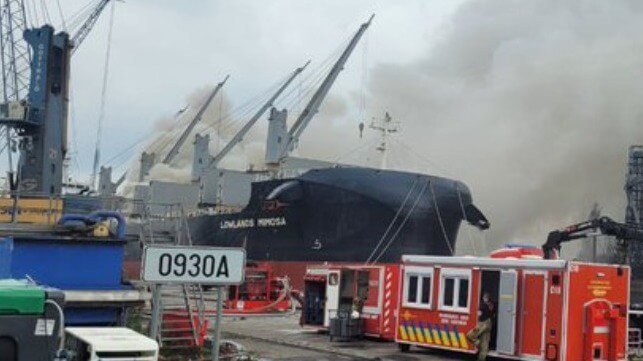
Firefighters in Belgium are struggling to put out a stubborn cargo fire on a bulker docked at the port of Ghent. They expect the fire will burn for at least 24 hours and possibly longer while warning residents and drivers to be cautious due to the thick smoke in the area.
The bulker Lowlands Mimosa is docked at the Sifferdok in Ghent. The 63,939 dwt vessel is managed by CLdN Cobelfret and reported loaded with a cargo of scrap metal. The bulker is 655 feet long and registered in Panama.
The local fire brigade received reports of the cargo fire at around 11:00 p.m. Thursday, June 23. Arriving at the port they found large quantities of smoke billowing from the hold of the vessel blanketing the port and spreading into the surrounding area. Warnings were issued for drivers to proceed with caution on local roads as well as for residents to close their windows due to the level of smoke.
The crew of the vessel had attempted to fight the fire before calling for assistance. One crewmember was taken to a local hospital suffering from smoke inhalation.
Firefighters reported that their work was being complicated by the position of the cargo in two holds aboard the ship. They were concerned with the vessel’s stability with a spokesperson reporting that they were pumping water on the fire but being forced to stop to pump water out of the ship’s holds as well.
By Friday morning, the firefighters were reporting that they believed the fire was under control and they had brought in a crane to begin removing the scrap metal to the dock as part of the fire fighting effort. Two firefighters have received minor injuries and were also taken to the local hospital.
